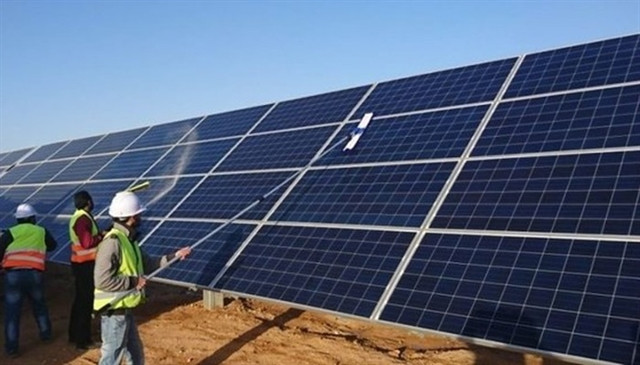 Maintenance of solar panels of a solar power project. The MoIT has been compiling the draft on FiT for solar power projects in the period from July 1, 2017 until December 31, 2021. (Photo vneconomy.vn)
Maintenance of solar panels of a solar power project. The MoIT has been compiling the draft on FiT for solar power projects in the period from July 1, 2017 until December 31, 2021. (Photo vneconomy.vn)Hanoi (VNS/VNA) - The Vietnam Electricity (EVN) group has agreed with continuing thecurrent feed-in tariff (FiT) rate at 9.35 US cents per kWh for rooftopsolar power projects nationwide until 2021 as proposed by theMinistry of Industry and Trade (MoIT).
This is the EVN'sfeedback on the ministry's draft mechanism for encouraging the development ofsolar power projects in Vietnam, including the FiT programme between July1, 2019 and December 31, 2021 as required by the ministry.
In the draft, theMoIT said it is necessary to maintain this tariff at 9.35 US cents untilthe end of 2021 nationwide aims at encouraging the development of rooftop solarpower projects.
This rate has beenapplying for all kinds of solar technologies, including floating solar powerprojects, ground-mounted solar power projects, rooftop solar power projects,under the FiT programme between June 1, 2017 and June 30, 2019.
EVN also said theState should not encourage investment in the development of solar powerprojects in areas with low solar irradiance and it needs to prioritisedevelopment of such projects in locations having high solar irradiance,reported vov.vn.
According to EVN, thepromotion of solar power investment in the low solar irradiance regions shouldbe considered later, taking into account payment ability of the finalconsumers.
Therefore, EVN hasagreed with the irradiance zonal classification of provinces and cities intotwo different zones to calculate tariff rates.
In middle-June, theministry submitted to the Government two plans on the tariffs with one based inthe irradiance zonal classification of provinces and cities into two differentzones and the other based on classification into four different zones thatwas submitted to the Government in May.
For the irradiancezonal classification of provinces and cities into two different zones, the FiTrates arrange from 6.67 to 7.89 US cents per kWh for a group of six provinceswith high solar irradiance known as Zone 2, including Ninh Thuan, Binh Thuan,Khanh Hoa, Dak Lak, Gia Lai and Phu Yen.
The remaining 57provinces and cities with lower solar irradiance known as Zone 1 will enjoy thetariff rates between 7.09 and 8.38 US cents depending on solar technologies.
Meanwhile, for theirradiance zonal classification into four different zones, there aresignificant differences in tariff rates.
In this calculation,the group of the six provinces mentioned above is known as Zone 4 with thelowest tariff rates, ranging from 6.67 to 7.89 US cents per kWh.
The tariff ratesrange from 9.2 to 10.87 US cents for Zone 1, including northern provinces withthe least potential in solar irradiance; from 7.91 to 9.36 US cents per kWh forZone 2; and from 7.09 to 8.72 US cents for Zone 3.
The ministry saidsetting the lowest tariffs in Zone 4 where the solar irradiance is highest willavoid a situation of concentrating solar power projects there becauseinvestment in transmission lines at those provinces does not keep up withinvestment in solar power projects. That makes completed projects unable tojoin to the national grid.
The wide-rangingtariffs for four different zones will encourage investors to develop solarpower projects in the northern and central provinces while the irradiancezonal classification of provinces and cities into two different zones could notdo so.
Thai Phung Ne, formerMinister of Energy and the Prime Minister's Envoy on power projects, said therewas rapid development of solar power projects over past years with capacity oftens of thousands of megawatts of solar power, reported the Dau tu (Investment)newspaper.
Those projects needmany 500kV and 220kV substations to solve the transmission of electricity tothe national grid.
However, thedevelopment of sub-stations does not catch up with the constructionof solar power projects.
First of all, theState needs to have location planning for developing solar power projects andalso planning on construction of transmission system, Ne said.
According to EVN, asof May 31, about 50 solar power plants have been put into operation with a totaldesigned capacity of about 2,481MW. There are about 4,000 customers mountingsolar panels on the rooftop with total capacity about 45MW.-VNS/VNA




























